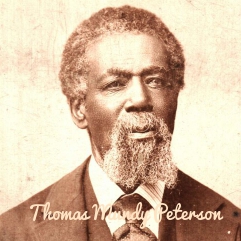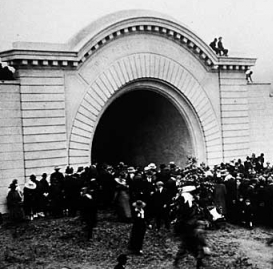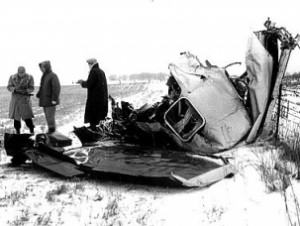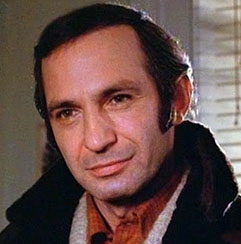Daily History Lesson – February 3
Whoever neglects learning in his youth loses the Past, and is dead to the Future. ~Euripides

1780 – In the first documented mass murder in America by an individual, 19-year-old Barnett Davenport beat Caleb Mallory, his wife Jane and 9-year old granddaughter Charlotte to death. Davenport, a boarder and farmhand on the Mallory grist mill and farm in Washington, CT, then looted the home before setting it on fire, killing Mallory’s two grandchildren; 6-year old John, and 4-year old Sherman.
Davenport was put on trial, which was presided over by Roger Sherman, who previously had served on the committee that wrote the Declaration of Independence. Sherman sentenced Davenport to forty lashes and then to be hanged. The execution took place at Gallows Hill on May 8, 1780.

1865 – President Abraham Lincoln and other officials from the Union met with a delegation of Confederate officials aboard the steamboat River Queen at Hampton Roads, a harbor in eastern Virginia, to discuss a possible peace agreement. Lincoln refused to grant the delegation any concessions, however, and the meeting ended within hours.
Alexander Stephens, Vice President of the Confederacy, asked if there was any way to stop the war and Lincoln replied that the only way was “for those who were resisting the laws of the Union to cease that resistance.”
The Confederate delegation underestimated Lincoln’s resolve to make the end of slavery a necessary condition for any peace. The president also insisted on immediate reunification and the laying down of Confederate arms before anything else was discussed.
In short, the Union was in such an advantageous position that Lincoln did not need to concede any issues to the Confederates. After less than five hours, the conference ended and the delegation left with no concessions. The war continued for more than two months.

1870 – The Fifteenth Amendment to the United States Constitution, prohibiting the federal and state governments from denying a citizen the right to vote based on that citizen’s “race, color, or previous condition of servitude,” was ratified as the third and last of the Reconstruction Amendments. It was formally adopted on March 30, 1870.
The first known black voter after the amendment’s adoption was Thomas Mundy Peterson, who cast his ballot on March 31, 1870 in the Perth Amboy, New Jersey mayoral election

1913 – The Sixteenth Amendment to the United States Constitution was ratified, authorizing the Federal government to impose and collect an income tax.
That led to the United States Revenue Act of 1913 signed into law by President Woodrow Wilson in October 1913. The incomes of couples exceeding $4,000, as well as those of single persons earning $3,000 or more, were subject to a one percent federal tax. Further, the measure provided a progressive tax structure, meaning that high income earners were required to pay at higher rates.
Wow, what a novel idea!

1918 – The Twin Peaks Tunnel in San Francisco began service as the longest (at the time) streetcar tunnel in the world at 11,920 feet long.

1924 – Woodrow Wilson, the 28th President of the U.S. (1913-1921), died of a stroke and other heart-related problems at the age of 67. He was interred in a sarcophagus in Washington National Cathedral.

1950 – Klaus Fuchs, a German-born British scientist who helped developed the atomic bomb, was arrested in Great Britain for passing top-secret information about the bomb to the Soviet Union. The arrest of Fuchs led authorities to several other individuals involved in a spy ring, culminating with the arrest of Julius and Ethel Rosenberg and their subsequent execution.
Fuchs was sentenced to 14 years in prison but was released in 1959 and immediately moved to East Germany, where he died in 1988.

1959 – Buddy Holly, Ritchie Valens, and J. P. “The Big Bopper” Richardson, died in an airplane crash near Clear Lake, Iowa.
Many more details are in the Rock & Roll History article.

1989 – Actor John Cassavetes (Rosemary’s Baby, The Dirty Dozen) died from cirrhosis of the liver at the age of 59.

1991 – Actress Nancy Kulp (best known for her role as Miss Jane Hathaway on The Beverly Hillbillies) died of cancer at the age of 69.
1994 – Nearly two decades after the fall of Saigon, President Bill Clinton announced the lifting of the 19-year-old trade embargo against Vietnam, citing the cooperation of Vietnam’s communist government in helping the United States locate the 2,238 Americans still listed as missing in the Vietnam War. In July 1995, the Clinton administration established full diplomatic relations with Vietnam.

1998 – Twenty Europeans, mostly Germans and Belgians, were taking a ski tram up Cermis Mountain in the town of Cavalese, Italy when an EA-6B Prowler operated by the U.S. Marines suddenly flew by. The anti-radar aircraft sliced through the steel cable holding up the tram and it plunged more than 250 feet to the ground. Everyone on board was killed instantly.
The pilot, Captain Richard J. Ashby, and navigator, Captain Joseph Schweitzer, destroyed a videotape that had recorded their flight before an investigation began. Still, it was soon discovered that the plane had been flying at only 360 feet above the ground, in spite of regulations that set the minimum altitude for flights at 2,000 feet.
In a military court at Camp Lejeune, North Carolina, Ashby and Schweitzer were charged with involuntary manslaughter and negligent homicide. They claimed that their equipment had malfunctioned and that their maps had not shown the location of the ski-lift. Despite Italian claims that American pilots regularly and intentionally ignored safety regulations to execute risky maneuvers, the crew was acquitted in March 1999. Ashby and Schweitzer were court-martialed for obstruction of justice for their destruction of the videotape and dismissed from the Marines.

2002 – The New England Patriots shocked football fans everywhere by defeating the heavily favored St. Louis Rams, 20-17 at Super Bowl XXXVI, to take home their first Super Bowl victory. Patriots’ kicker Adam Vinatieri made a 48-yard field goal to win the game as the clock expired.

2003 – Actress Lana Clarkson (Barbarian Queen) was murdered by record producer Phil Spector. She was 40.

2008 – The New York Giants stunned the New England Patriots in Super Bowl XLII, pulling off one of the biggest upsets in Super Bowl history. New England came into the game with an unblemished 18-0 record and held a 14-10 lead in the closing moments of the fourth quarter.
With just one minute, 15 seconds remaining and their Super Bowl hopes dwindling, Giants quarterback Eli Manning pulled away from several Patriots defensive players and threw the ball down the field. Little-used wide receiver David Tyree out-jumped Patriots safety and four-time All-Pro Rodney Harrison to catch the ball, cradling it against his helmet with one hand as the two men fell to the ground. Four plays later, with only 35 seconds left on the clock, Manning tossed the game-winning touchdown into the hands of Plaxico Burress.

2012 – Actor Ben Gazzara (Anatomy Of A Murder, The Bridge At Remagen, Husbands, Capone, Road House and television’s Run For Your Life) died of pancreatic cancer at the age of 81.
Compiled by Ray Lemire ©2016 RayLemire.com. All Rights Reserved.